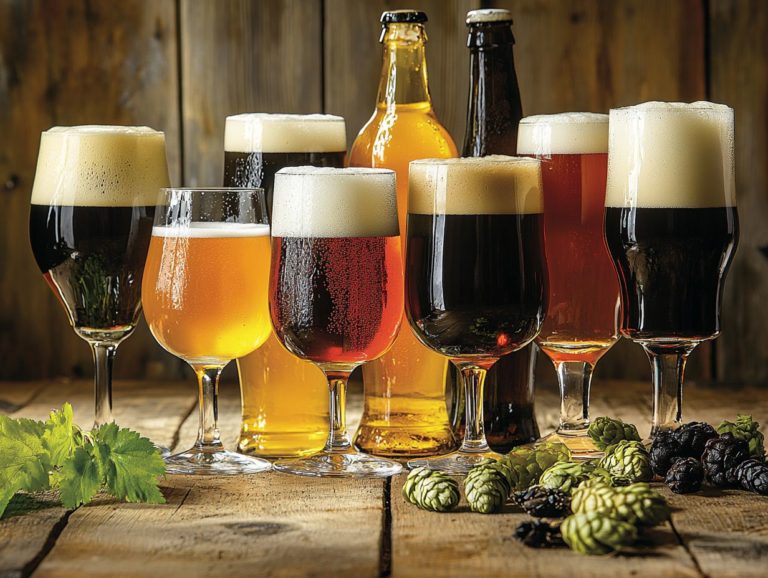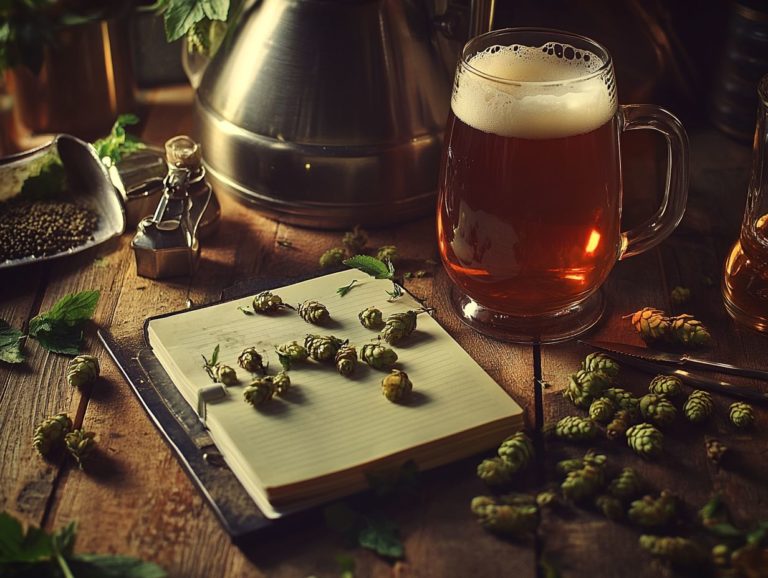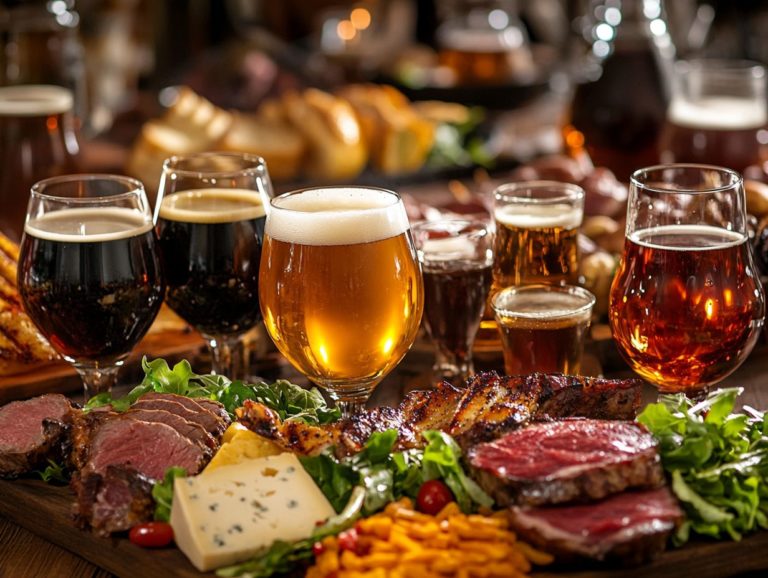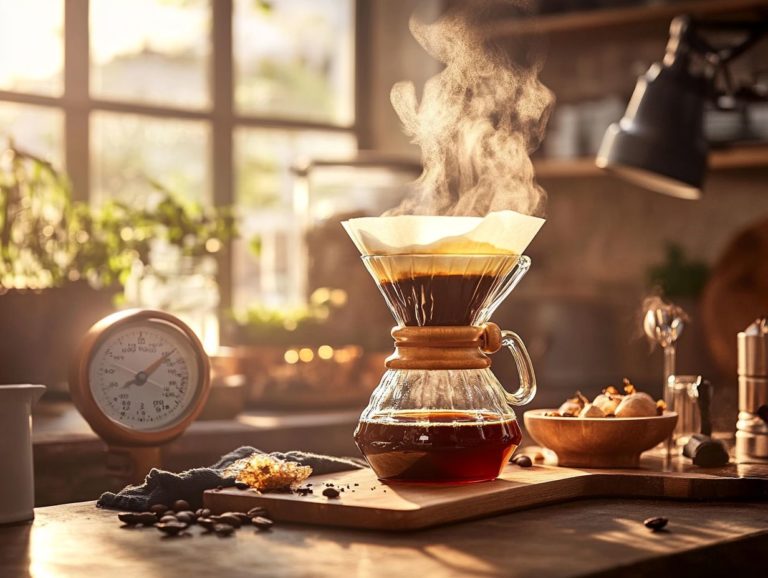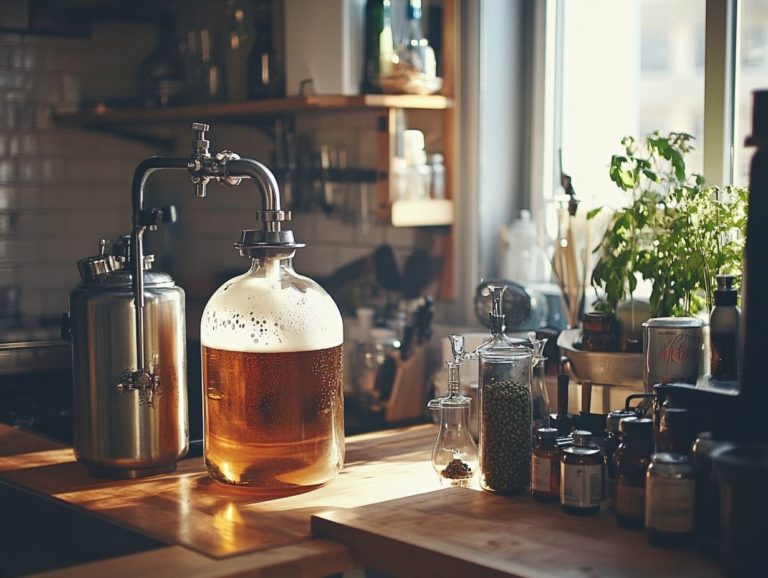Tips for Pairing Hops with Malts
In the world of brewing, the delicate dance between hops and malts can truly transform your final product. Grasping the nuances of these essential ingredients and their interactions is crucial for every brewer, whether you re just starting out or have years of experience under your belt.
This article delves into the significance of harmonizing hops with malts, guiding you in selecting the ideal varieties, and sharing tips for achieving that perfect balance in your beer. You ll also uncover common pitfalls to steer clear of, ensuring that your brews rise above the ordinary. Get ready to take your brewing skills to the next level with exciting techniques like dry hopping and sampling!
Key Takeaways:
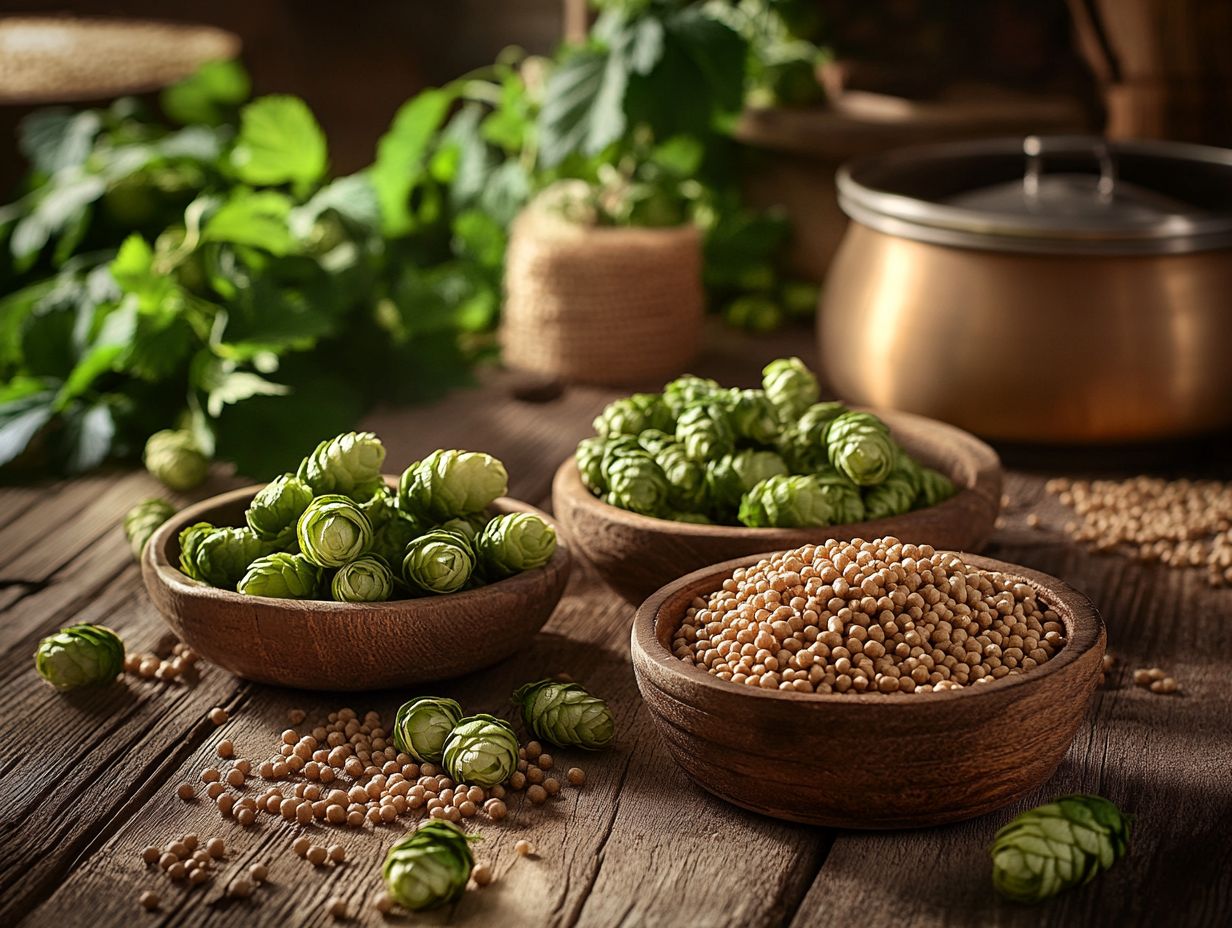
- Choose hops and malts that complement each other’s flavor profiles.
- Consider the beer style when pairing hops and malts to ensure a cohesive and balanced taste.
- Avoid common mistakes such as using too many hops or choosing incompatible flavors that can result in an unbalanced beer.
Contents
- What Are Hops and Malts? Understanding the Basics of Brewing Ingredients
- Why Is It Important to Pair Hops with Malts?
- How to Choose the Right Hops for Your Malts?
- How to Choose the Right Malts for Your Hops? A Guide to Perfect Pairing
- Pairing Hops and Malts: Tips and Tricks
- Consider the Beer Style
- Common Mistakes to Avoid When Pairing Hops with Malts
- 1. Using Too Many Hops
- Frequently Asked Questions
- What are some tips for pairing hops with malts?
- Can I pair any type of hops with any type of malt?
- How can I experiment with different hop and malt combinations?
- Are there any classic hop and malt pairings to try?
- What about pairing hops and malts for specific beer styles?
- Can I use multiple hops and malts in one beer?
What Are Hops and Malts? Understanding the Basics of Brewing Ingredients
Hops and malts are essential ingredients in the brewing process, playing a pivotal role in shaping the overall flavor, aroma, and character of your beer. Hops, known for their smells and tastes that can be bitter, are essential in defining the beer’s bitterness and achieving balance. Meanwhile, malts contribute sweeter and complex flavors, harmonizing beautifully with those hop flavors.
Grasping the intricate relationship between these two components is crucial for any homebrewer who aspires to master a variety of beer styles, whether it’s a juicy NEIPA or a classic lager. For those looking to dive deeper, resources like “Mastering Homebrew” can be invaluable.
In this guide, you ll delve into the fundamental characteristics of hops and malts, uncovering their significance in the art of crafting exceptional beers.
Why Is It Important to Pair Hops with Malts?
Pairing hops with malts is essential for crafting balanced flavors and aromas. This enhances your overall drinking experience. The right combination of these ingredients can create a harmonious blend that highlights the unique characteristics of each, resulting in a beer that is not just enjoyable but also intriguingly complex.
For example, when you pair the citrusy notes of Citra hops with the caramel sweetness of Munich malt, you can elevate a pale ale to new heights. This importance of pairing underscores the necessity for you to experiment with various combinations and recipes across different beer styles. Utilize a hop pairing guide to make informed decisions and avoid common pitfalls.
How to Choose the Right Hops for Your Malts?
Selecting the right hops for your malts is a pivotal aspect of brewing that can significantly impact the flavor profile and overall quality of your final product. Different hops bring unique aromas and flavors to the table, ranging from the tropical notes of Citra to the herbal qualities of Saaz.
Grasping these characteristics is essential for you to craft a well-balanced beer. Factors like alpha acid levels and hop varieties significantly impact the bitterness and aroma of your brew.
By thoughtfully considering these elements, you can create distinctive and delightful beers that cater to your personal taste preferences.
1. Consider the Flavor Profile of Hops
When selecting hops, it s crucial for you to consider the flavor profile you wish to achieve, as each hop variety brings its own unique set of flavors and aromas to the table. Understanding how these flavors interact can help you create a beer that is both balanced and delightful to the palate. Explore single hop and SMaSH (Single Malt and Single Hop) techniques to better understand each hop’s contribution.
For instance, if you re crafting a pale ale, using hops like Cascade or Centennial can infuse floral and citrus notes that beautifully complement the malt backbone. If you re leaning toward a robust stout, incorporating hops such as East Kent Goldings or Fuggles can introduce earthy and herbal undertones, adding depth to your brew’s complexity.
On the other hand, a West Coast IPA often thrives on the bold, piney flavors of Simcoe or Chinook hops, creating a striking contrast to the sweeter malts. Each hop variety carries its distinct characteristics, including bitterness levels and aroma profiles, which are essential in shaping the final taste experience.
By selecting the right hops, you can elevate the overall enjoyment for anyone who savors your creation.
2. Determine the Alpha Acid Levels
Alpha acid levels in hops are an important measure for determining the bitterness of your brew, with higher alpha acid content typically delivering a more pronounced hoppy flavor. When you select your hops, consider how their alpha acid levels will interact with the sweetness of your chosen malts to achieve a harmonious balance in your beer’s overall profile.
For example, pairing a high-alpha hop like Simcoe with a sweeter malt can create a delightful contrast that elevates your beer’s complexity. Additionally, choosing the right hop variety based on alpha acid levels will dramatically change how your beer tastes!
Typically, hops with alpha acid contents ranging from about 3% to 20% can provide varying levels of bitterness. Familiarity with different hops and their acid levels gives you the power to experiment, leading to unique profiles that cater to your individual preferences.
You might decide to add high-alpha hops early in the boil to maximize bitterness while saving lower-alpha hops for later additions to enhance aroma and flavor without overshadowing the sweetness.
3. Look at the Hop Variety
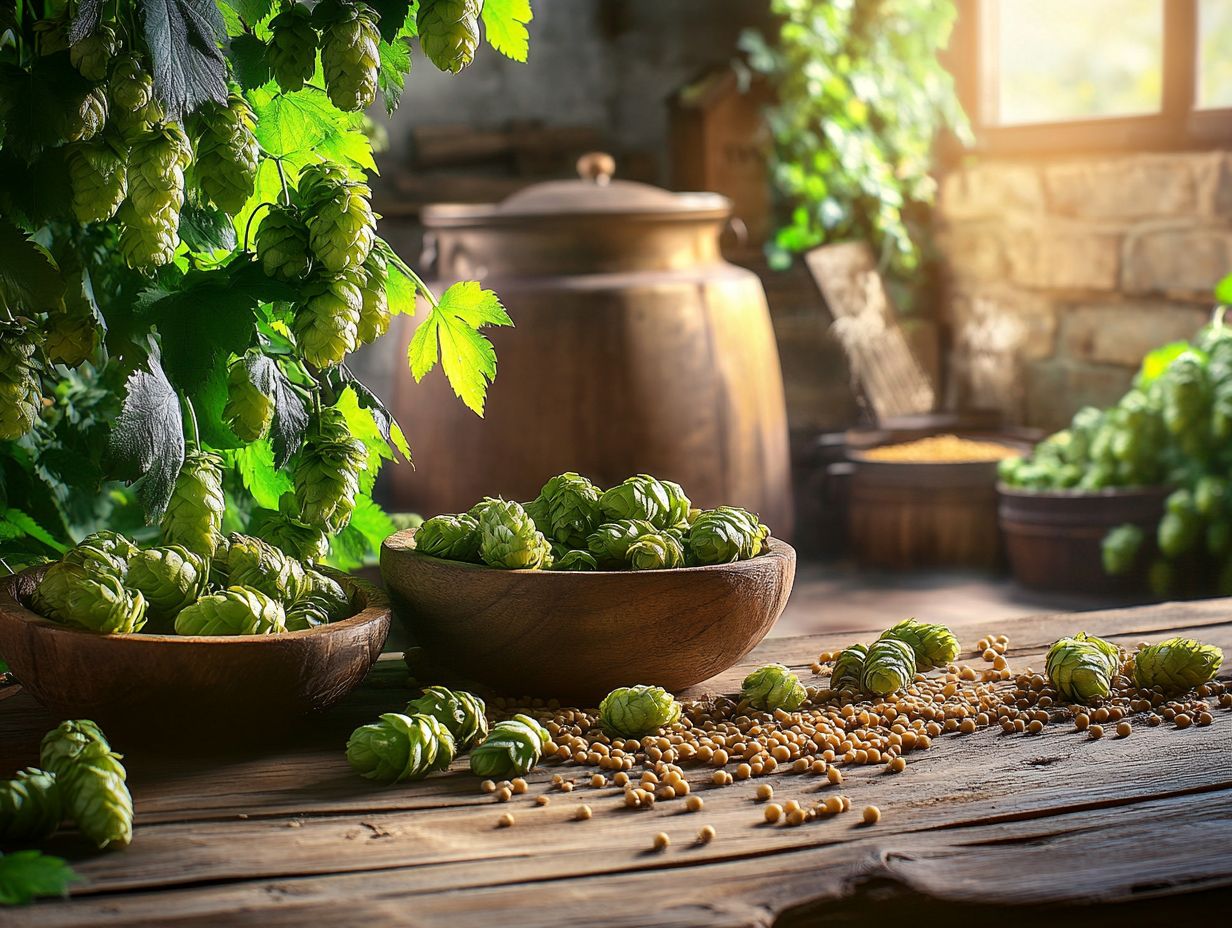
Different hop varieties offer a spectrum of flavors and aromas that make it essential for you to explore an array of options when selecting hops for your brewing endeavors. Take Citra hops, for instance; they re celebrated for their vibrant tropical fruit notes, while Amarillo can add delightful hints of orange and floral undertones to your brew.
This exploration is crucial not just for achieving a particular taste but also for elevating the overall drinking experience. Consider Simcoe hops, which bring a piney and earthy aroma ideal for crafting bold IPAs. On the other hand, Mosaic hops offer a complex medley of flavors, including berry and citrus, which can enhance the profile of a pale ale.
By incorporating a diverse range of hop varieties, you empower yourself to create unique recipes that cater to different palates and preferences. Engage with the brewing community on platforms like blogs and podcasts such as “For the Love of Hops” and “Basic Brewing Radio” to stay updated and receive feedback.
Whether you re aiming for bitterness or aroma, the right combination of hops can transform an ordinary beer into something extraordinary, inviting drinkers to savor each sip. Start experimenting with hops today, and transform your brewing journey!
How to Choose the Right Malts for Your Hops? A Guide to Perfect Pairing
Selecting the right malts to complement your chosen hops is crucial in the brewing process. The balance between these two ingredients truly defines the character of your final beer. Choose your malts wisely to achieve the best flavor! Consider integrating recipes and brewing techniques from recognized brands and competitions to refine your approach.
Malts bring sweeter, body, and color to the mix, which can either enhance or soften the bitterness and aroma of the hops. For instance, pairing a light-colored malt with fruity hops achieves a refreshing pale ale. In contrast, incorporating darker malts can introduce complexity and richness to a stout.
Grasping the relationship between hops and malts is essential for any brewer looking to craft a harmonious beer experience. Engage in research and feedback within the brewing community to fine-tune your process.
1. Consider the Color
The color of the malts you choose for brewing can significantly impact both the visual appeal and the taste of your final beer. It is essential to carefully consider your malt selections in conjunction with your hops. For example, opting for light malts will yield a pale golden ale. Meanwhile, dark roasted malts will lend themselves to the rich, deep hues found in stouts and porters.
The look of the beer affects expectations about its taste. When you encounter a vibrant amber or coffee-brown brew, it s only natural to anticipate a robust or sweet flavor profile. Take the Belgian Dubbel, for instance; its deep mahogany hue sets the stage for expectations of caramel and toffee notes.
Incorporating crystal malts can elevate your brew’s richness while adding depth of color. This further enhances the overall sensory experience. The interplay between malt and hop colors not only captivates the eyes but also guides the palate. This reinforces the notion that color is an essential element in the artistry of brewing.
Complement these visual and flavor elements with attentive fermentation and water quality practices to ensure consistency.
2. Determine the Flavor Profile: Crafting the Perfect Blend
Just as you delve into the world of hops, grasping the flavor profile of your chosen malts is essential for crafting a well-balanced beer that beautifully showcases both sweetness and complexity. Each malt variety offers a unique spectrum of flavors; for instance, Munich malts provide caramel and toasty notes, while pale malts deliver delightful biscuity flavors.
By thoughtfully selecting malts that harmonize with your intended hop character, you can create a beer that truly captivates the drinker’s palate. Ingredients such as Simcoe or Amarillo hops can also add depth.
To effectively evaluate these flavor profiles, consider conducting small test brews or experiments using various malt combinations. Tasting these samples at different stages of fermentation will deepen your understanding of how the malt interacts with hops. This interaction can exhibit vibrant citrus or resinous characteristics.
For example, pairing the rich, roasted tones of a chocolate malt with a tropical hop variety, such as those used in NEIPA (New England India Pale Ale), can elevate the overall complexity of your brew, revealing subtle flavors that might otherwise stay hidden.
This methodical approach ensures that your final product not only shines with aromatic excellence but also maintains a harmonious and pleasing malt backbone.
3. Look at the Malt Variety and Techniques
Exploring the diverse world of malt varieties and brewing methods is crucial for any brewer, as each type offers unique flavors that can elevate the characteristics of your selected hops.
For example, Pale malt acts as a versatile backbone, providing the sweetness and body that beautifully complement floral hop varieties like Saaz. Specialty malts such as Crystal can infuse your brew with rich notes of caramel and toffee, expertly balancing the bitterness of hops like Centennial and crafting a well-rounded taste experience.
By daring to experiment with different malt combinations, you can create unique recipes that truly stand out in today s competitive craft beer scene. Utilizing a variety of malt profiles allows you to achieve the flavor nuances you desire, ensuring that your final product captures the essence of both the malt and the hop, resulting in a brew that is not only pleasing but also memorable. Consider experimenting with SMaSH (Single Malt and Single Hop) recipes to get a better understanding of individual ingredient impacts.
Pairing Hops and Malts: Tips and Tricks
Successfully pairing hops and malts is an art form that demands both understanding and experimentation. This gives you the power to craft unique flavors and aromas in your beer. Whether you re a seasoned homebrewer or just beginning your journey, these tips and tricks will guide you in creating well-balanced brews.
By experimenting with various combinations of hops and malts based on their flavor profiles, you can elevate the complexity of your beer, allowing you to design exciting recipes that cater to your personal tastes.
1. Balance Bitterness and Sweetness
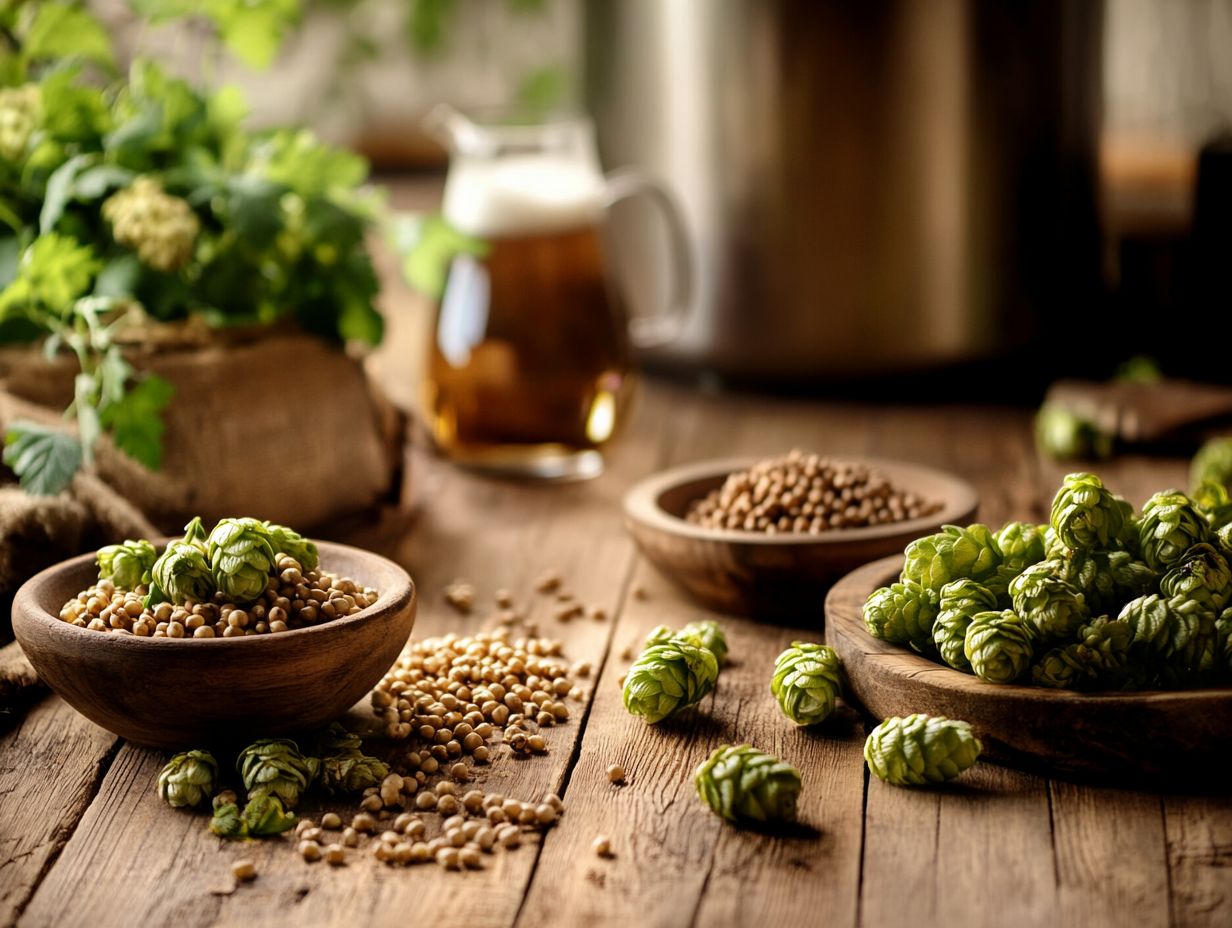
Finding the right balance between bitterness and sweetness is essential when pairing hops and malts, as it profoundly shapes your overall flavor experience in beer. For instance, if you choose hops that have a high level of alpha acids, which contribute to bitterness, you ll need to select malts that offer just enough sweetness to create harmony, ensuring that neither element overshadows the other.
This balance is especially crucial in styles like IPAs and stouts, enhancing the drinkability and complexity of your final brew.
Getting to this equilibrium often means experimenting with different varieties of hops and malts. This allows you to uncover unique profiles that can surprise and delight your palate. Imagine the bright, zesty notes of Citra hops dancing perfectly with the rich sweetness of caramel malt. This combination creates a taste sensation that your palate will adore!
Be mindful of common pitfalls, such as relying too heavily on one end of the spectrum. Overly bitter brews can mask the delicate nuances of the malt, while excessively sweet offerings might lead to a cloying finish. Thus, mastering this balance opens the door to crafting exceptional beers!
2. Experiment with Different Combinations
Experimenting with different combinations of hops and malts is essential for you as a brewer who wants to expand your flavor profiles and create truly unique beers. Each brew offers a fresh opportunity to try new pairings, whether it s blending fruity hops like Citra with biscuity malts or experimenting with herbal hops alongside darker, roasted malts.
Consider dry hopping for added aromas and complexity. This adventurous approach brings delightful surprises and enhances your brewing skills.
Consider how elements such as your brewing method, fermentation temperatures, and even water chemistry can significantly influence the final result. Engaging in this experimental journey helps you hone your craft and fosters creativity, encouraging you to rethink traditional boundaries.
Collaborating with other brewers or attending tasting events, reading blogs, or listening to podcasts like Basic Brewing Radio can ignite inspiration, revealing unexpected yet harmonious flavor profiles. Therefore, embracing these variables and allowing your curious nature to guide you is essential for any brewer aiming for innovation in their craft.
Consider the Beer Style
When you’re pairing hops and malts, it’s essential to keep the specific beer style you’re aiming to brew in mind, as each style comes with its own distinct flavor profile and expectations.
For example, IPAs thrive on bold, citrusy hops like Cascade, while stouts often shine with chocolate or roasted malts that beautifully enhance the beer s rich character. Researching and understanding different beer styles can provide valuable insights for successful combinations.
By understanding these nuances, you can craft recipes that not only adhere to style guidelines but also hold the potential for success in competitions.
Beyond IPAs and stouts, other beer styles also call for unique hop and malt combinations. Take lagers, for instance; they often make use of noble hops such as Saaz or Hallertau, which pair harmoniously with light, crisp malts to deliver a refreshing finish. A hop pairing guide is a useful tool for these situations.
On the flip side, Belgian beers typically showcase fruity esters and spices in conjunction with caramel malts, resulting in a complex depth of flavor that s unmistakably recognizable. By honoring these traditional flavor profiles, you enhance the overall drinking experience while paying tribute to the beer’s origins, ensuring that each brew remains true to its stylistic heritage.
Common Mistakes to Avoid When Pairing Hops with Malts
Be on the lookout for common mistakes that can detract from the quality of your final beer, resulting in unbalanced or off-putting flavors. Recognizing these pitfalls is crucial for homebrewers like you who aspire to refine their craft and produce exceptional beers that truly stand out. Resources such as “For the Love of Hops” or “Mastering Homebrew” provide valuable insights that can help you avoid these errors.
Some of these missteps include using an excessive amount of hops that can hide the subtle flavors of your malts, combining flavors that simply clash, or failing to consider the specific style of beer you are aiming to create. Feedback from the brewing community can be invaluable in identifying and correcting these issues.
1. Using Too Many Hops
One of the most common pitfalls in brewing is the tendency to use too many hops, which can result in an overwhelming bitterness that hides the subtle flavors of your malts. While hops play an essential role in adding aroma and flavor, it s vital for you to find that ‘sweet spot,’ or ideal balance, to achieve harmony in flavors.
Imagine crafting an IPA that’s crammed with hops; it may lose the delightful nuances that make it truly enjoyable, like the sweet touch from caramel malts. Using a hop pairing guide can help in finding the right balance.
When you overload on hops, you risk creating a one-dimensional taste, where your beer transforms into a sharp blast rather than a harmonious medley of flavors. As a brewer, you must consider how different hop varieties interact with malt characteristics and other ingredients. A well-balanced beer often emerges from careful planning, where the bitterness from hops enhances rather than obliterates the malt sweetness.
A solid approach is to experiment gradually, adjusting your hop levels until the desired flavor profile reveals itself. This method leads to a satisfying experience that highlights your brewing skills. Engaging in research and continuous learning through resources like brewing blogs or podcasts can also enhance your skills.
2. Choosing Incompatible Flavors
Choosing incompatible flavors when pairing hops and malts can result in a beer that lacks balance and is far from pleasant to drink. For instance, if you pair a highly bitter hop with overly sweet malts without giving it much thought, you could end up with a clash that detracts from the flavor experience you intended to create. Understanding the properties of both hops and malts is crucial in avoiding this common pitfall during the brewing process.
Resources like a hop pairing guide can help in identifying compatible ingredients. To steer clear of unfavorable combinations, it s wise to examine the characteristics of the various ingredients you re working with. Take earthy hops like Fuggle, for example; they may not meld well with caramel malts, potentially leading to a muddled flavor profile. Researching hop and malt pairings can help.
Many brewers have discovered that pairing floral or citrus hops with lighter, biscuit-like malts can elevate the overall freshness and brightness of the beer. Pay attention to the aroma, bitterness levels, and sweetness of the hops and malts. This will help you craft a more harmonious brew.
Ultimately, a well-considered pairing enhances the sensory experience, balancing the myriad of flavors to create a captivating beer that truly invites enjoyment. Join fellow brewers and share your amazing recipes for valuable insights!
3. Not Considering the Beer Style and Process
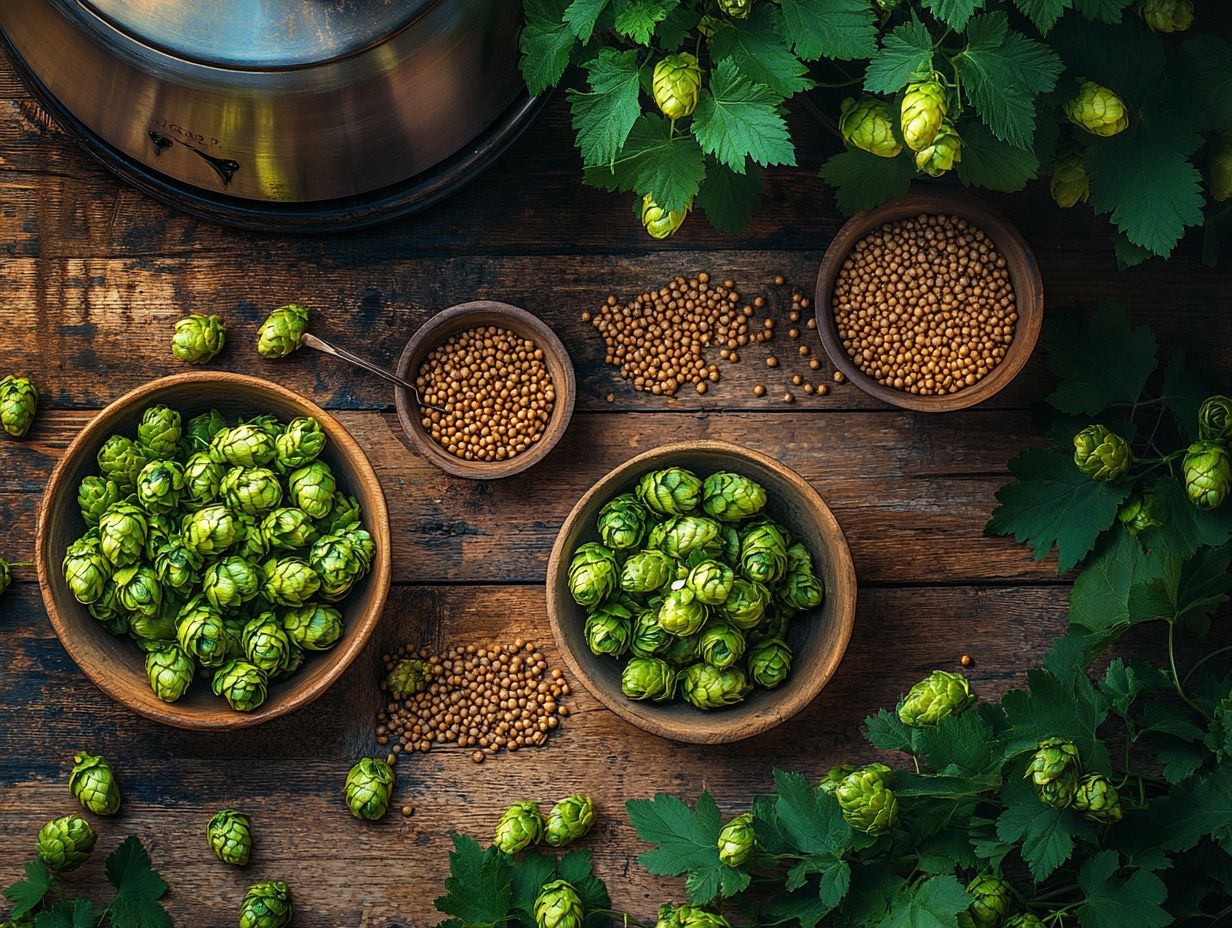
Failing to consider the specific beer style when pairing hops and malts is a misstep that can lead to inconsistent results and unsatisfactory brews. Each beer style possesses established flavor profiles that guide your ingredient choices. For instance, a pale ale typically shines with hops like Cascade or Amarillo, while a porter may call for roasted malts to enhance its rich character. Overlooking these guidelines risks crafting a beer that feels disjointed and lacks cohesion.
As a craft brewer, it s essential to understand that adhering to these standards transcends tradition; it s about creating a harmonious drinking experience. Take the classic India Pale Ale, where the intricate balance between bitterness and sweetness relies on both aromatic and bittering hops, such as Citra, Simcoe, or Centennial, paired with light malts to showcase the hop character.
Exploring different styles like NEIPA can also introduce tropical and herbal notes to your brewing. On the other hand, a well-executed stout depends on dark roasted malts to deliver a complex blend of coffee, chocolate, and caramel notes, ensuring that every sip aligns perfectly with expectations. Techniques like dry hopping can add layers of aromas and flavors.
Ultimately, mastering these ingredient choices gives you the power to create beers that not only adhere to stylistic guidelines but also delight and surprise the palate with their complexity.
Join our vibrant brewing community today! Share your process, get feedback, and elevate your brewing game!
Frequently Asked Questions
What are some tips for pairing hops with malts?
1. Consider the flavor profile of your desired beer: Certain hops and malts have distinct flavor profiles that can complement or clash with each other. Matching them accordingly can result in a well-balanced brew. Researching traditional combinations and reading brewing blogs can help you make informed choices.
2. Start with the base malt: The base malt is the foundation of your beer, so choose it first and then select hops that will enhance its flavors. For a unique twist, try a SMaSH (Single Malt and Single Hop) recipe to focus on the characteristics of individual ingredients.
3. Keep the intensity in mind: Stronger hops and malts can easily overpower each other, so it’s important to balance them carefully to create a harmonious flavor. Homebrewing forums and feedback from the brewing community can be valuable tools in refining your recipes.
Can I pair any type of hops with any type of malt?
No, it’s important to consider the characteristics and flavors of both the hops and malts to create a successful pairing. Some combinations may result in unpleasant flavors. Using a hop pairing guide can be a useful tool in this process.
How can I experiment with different hop and malt combinations?
One way is to use brewing software or a recipe calculator to play around with different hop and malt combinations before actually brewing. You can also try small test batches to see how different combinations work together. Engaging in homebrewing competitions can also provide valuable feedback and new ideas.
Are there any classic hop and malt pairings to try?
Yes, some classic pairings include Cascade hops with pale malt for a classic American pale ale, and Fuggle hops with Maris Otter malt for an English-style bitter. Saaz hops and Pilsner malt are also traditional choices for a crisp German pilsner.
What about pairing hops and malts for specific beer styles?
For specific styles, it’s important to research the traditional hop and malt combinations used for that style. For example, a German pilsner typically uses Noble hops and German pilsner malt. Reading books like “For the Love of Hops” and “Mastering Homebrew” can provide detailed insights into these traditional pairings.
Can I use multiple hops and malts in one beer?
Absolutely! Mixing and matching different hops and malts can result in complex and unique flavors in your beer. Just be sure to keep the intensity and balance in mind when choosing multiple ingredients. Listening to brewing podcasts like “Basic Brewing Radio” can offer tips and inspiration for your combinations.

